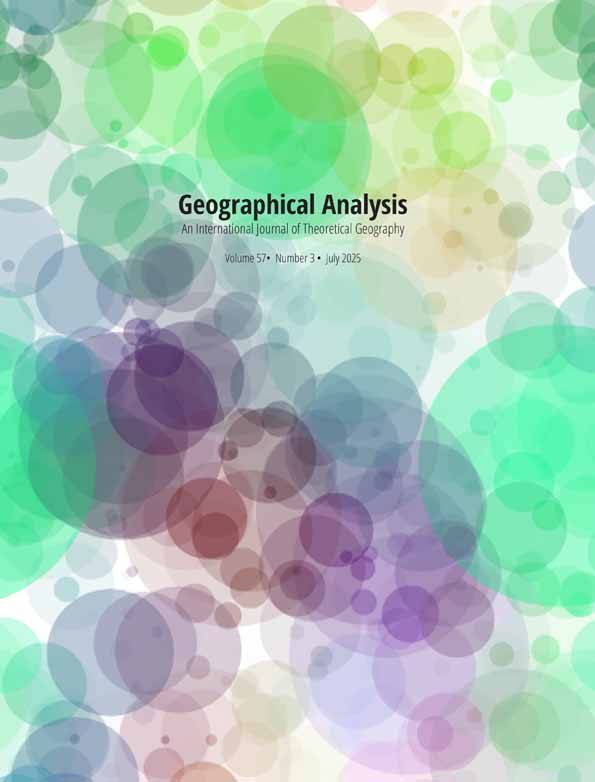Free Access
Regionalization: Theory and Alternative Algorithms
Philip M. Lankford,
Philip M. Lankford
Philip M. Lankford is a Ph.D. candidate in geography at the University of Chicago.
Search for more papers by this authorPhilip M. Lankford,
Philip M. Lankford
Philip M. Lankford is a Ph.D. candidate in geography at the University of Chicago.
Search for more papers by this author
LITERATURE CITED
- 1 Berry, B. J. L. “A Method for Deriving Multi-Factor Uniform Regions,” Przeglad Geograficzny, 33 (1961), 263–279;
- 2 Berry, B. J. L. “Mathematical Methods of Economic Regionalization,” Proceedings of the Brno Conference on Economic Regionalization. (Brno: Czechoslovakian Academy of Sciences, 1966).
- 2 Blumenthal, L. M. Theory and Application of Distance Geometry. (London: Oxford Clarendon Press, 1953).
- 3 Bunge, W. Theoretical Geography. (Lund: Royal University of Lund, Department of Geography, 1962).
- 4 DeJong, G. Chorological Differentiation as the Fundamental Principle of Geography. (Groungen: J. B. Walters, 1962).
- 5 Friedman, H. P., and J. Rubin. “On Some Invariant Criteria for Grouping Data,” Journal of the American Statistical Association, 62 (1967), 1159–1178.
- 6
Grigg, D.
“The Logic of Regional Systems,”
Annals of the Association of American Geographers, 55 (1965), 465–91
10.1111/j.1467-8306.1965.tb00529.x Google Scholar
- 8 Grigg, D. “Regions, Models, and Classes,” in Models in Geography, ed. R. J. Chorley and P. Haggett. (London: Methuen, 1967), pp. 461–509.
- 7 Hartigan, J. A. “Representation of Similarity Matrices by Trees,” Journal of the American Statistical Association, 62 (1967), 1140–1158.
- 8 Johnston, R. J. “Choice in Classification—The Subjectivity of Objective Methods,” Annals of the Association of American Geographers, 58 (1968), 575–89.
- 9 Kaiser, H. F. “An Objective Method for Establishing Legislative Districts,” Journal of the Midwest Political Science Association, 20 (1964), 75–100.
- 10 McQuitty, L. L. “Elementary Linkage Analysis,” Educational and Psychological Measurement, 17 (1957), 207–229.
- 11 Neely, P. General Discussion re: Neighborhood Limited Classification, and Towards a Theory of Classification. (Mimeographed, University of Chicago, n.d.).
- 12 Regional Science Research Institute. Regionalization of Pennsylvania Counties for Development Planning. ( Unpublished discussion paper, n.d.).
- 13 Rosenblatt, D. “Aggregation in Matrix Models of Resource Flows,” The American Statistician, 21 (1967), 32–38.
- 14 Rozin, M. S. “Review of L. Y. Ziman's ‘Economic Regions of the United States.’” Soviet Geography, Vol. 2 (1961), pp. 60–65.
- 17 Alampiev, P. M., “Economic Regionalization.” in Soviet Geography, Accomplishment and Tasks, ed. C. D. Harris (New York: American Geographical Society, 1962)
- 18 Rodoman, B. B., “Mathematical Aspects of the Formalization of Regional Geographic Characteristics,” Vestnik Moskovskogo Universiteta, 23 (1967), 28–44, are studies illustrative of Russian work on this topic. Polish studies include.
- 19 Kondracki, J., “Natural Regions of Poland,” Przeglad Geograficzny, 28 (1956), 48–60
- 20 Dziewonski, K., “Elements of the Theory of Economic Regions,” Przeglad Geograficzny, 33 (1961), 593–613.
- 15 Rubin, J. Optimal Classification into Groups: An Approach for Solving the Taxonomy Problem. (Mimeographed, IBM Mathematics and Application Department, New York: May, 1965).
- 16 Sokal, R. R. “Distance as a Measure of Taxonomic Similarity,” Systematic Zoology, 10 (1961), 70–79.
- 17 Stone, R. “Comparison of the Economic Structure of Regions Based on the Concept of Distance,” Journal of Regional Science, 2 (1966), 1–20.
- 18 Ward, J. H., Jr.. “Hierarchical Grouping to Optimize an Objective Function,” Journal of the American Statistical Association, 58 (1963), 236–43.




